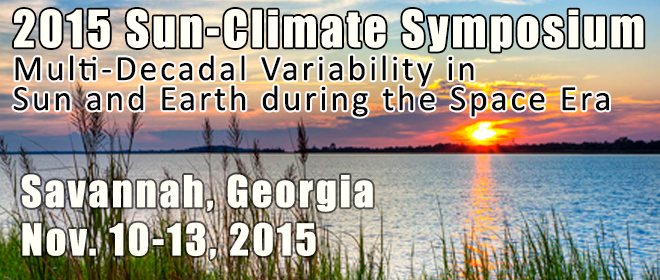2015 Sun-Climate Symposium

1. Total Solar Irradiance (TSI) Measurements and Modeling
This session will address the total solar irradiance (TSI) measurement record since 1978, with emphasis on how measurements of the last decade have been reconciled, and have contributed to new TSI composite record with associated time-dependent uncertainties; how variability in Sun-like stars improves our understanding of the Sun’s behavior over the past three decades.
2. Sun-Climate Connection: Top-down and bottom-up couplings
This session will discuss the possible links in Sun-Climate connection, including top-down and bottom-up couplings. What have we learned about the Sun’s influence on the earth’s atmosphere during the satellite era, in particular over the multi decadal time scale? How well are climate models able to capture these links?
3. Climate Changes during the Space Era
This session will discuss Earth’s climate changes driven by anthropogenic and natural forcing. Observations of the Sun and Earth from space have provided a new insight in solar variability and its influence on terrestrial atmosphere for more than three solar cycles. How have these observations helped to enhance our knowledge of climate change to get an assessment of future climate?
4. Solar Spectral Irradiance (SSI) Measurements and Modeling
Recent challenges in the SSI observational record will be discussed over the full spectrum (UV-VIS-NIR), including recent progress on understanding spectral variability over the past solar cycle; spectral irradiance composites and comparisons with state-of-the-art irradiance modeling.
5. Societal Impacts from Climate Change and Solar Variability
Climate change can have potential impacts on social and economic implications as well as geophysical change. How can we transform our knowledge of climate change to improve the life of humanity? What is the current status of our understanding of sea ice loss and sea level rise and its impact on our daily lives?
6. Variability of the Sun-like stars
This session will address the following questions: How typical is the cyclic activity of our Sun relative to Sun-like stars? What have we learned from the Kepler mission and ground-based synoptic programs about the ranges of total and spectral irradiance variability? What progress have we made in understanding what controls the cycle length and activity range of a Sun-like star?
7. Challenges and Opportunities for Solar Observations
This session will address the observational requirements for improving our ability to quantify the solar forcing of the Earth system and interpreting its response.
8. Next Generation Observing Systems for Climate Records
This session will discuss new missions, sensors, and implementation strategies required for a next-generation observing system to meet the current and future challenges facing climate change studies.



